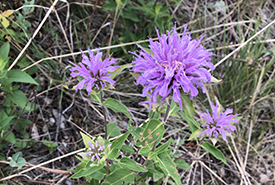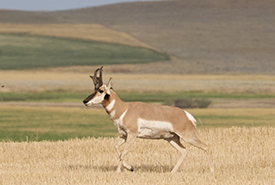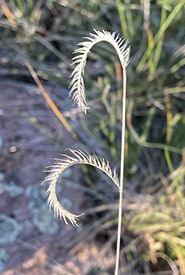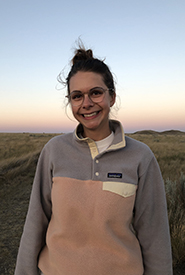Grasslands, close-up

Western bergamot (Photo by NCC)
As a conservation intern with the Nature Conservancy of Canada (NCC) this past summer, I have had the wonderful opportunity to explore the land that we help conserve here in Saskatchewan. Growing up in this province, I developed a love for the peaceful, scenic quality of grasslands; but this summer, I gained a new-found appreciation for some of the hidden treasures this ecosystem holds that are easy to miss if you’re not looking close enough.
From a zoomed-out perspective, Saskatchewan’s prairie grasslands offer a serene picture. When out at some of the NCC properties in the province, there may not be another human around for kilometres, and you can practically see that far, too. With only sporadic clumps of shrubs or aspen on the landscape, the unobscured view lends itself to wide stretches of horizons, perfect for living sky viewing. The only sounds you may notice are the wind rustling the grass or the chorus of grasshoppers. And while all of this in itself is something to behold, the real magic is found when you zoom in.

Pronghorn (Photo by Liam Ragan, CC BY-NC 4.0)
After spending much of the summer getting up close and personal with grasslands while monitoring and conducting ecosystem health assessments on the properties, I have discovered the world beyond the large-scale view. While hiking through the Prairies, I soon found that they were teeming with hidden wildlife. Grassland birds and waterfowl that nest in long grass and shrubs will sometimes wait until you are within an arm’s reach before letting you know that they are there, flushing in a tizzy to reveal a perfect nest. Deer and pronghorn also do a magnificent job of camouflaging themselves in their surroundings and appear seemingly out of nowhere to prance across the plains. You also might find yourself tripping over a burrow in the ground that could be home to ground squirrels, coyotes or badgers; I can only imagine the complex underground networks that exist below my feet. Although tripping over a burrow isn’t always all so bad, because once you are down on your hands and knees, another world of unique plant species reveals itself.

Blue grama (Photo by syegilmore, CC BY-NC 4.0)
I was grateful this summer to learn a few things about grassland plant identification, which has given me a greater appreciation for the ecosystem. Some of my favourite grassland plant species are western bergamot, a fragrant forb with a striking purple flower, and blue grama, a short grass whose seed head resembles a row of eyelashes. I find it fascinating how throughout the year — between early spring to late summer — different species of wildflowers will be in bloom at different times and can act as a way of knowing how far along in the season we are.
I’m so glad I was able to spend this summer looking closely at all the things that make the grasslands the complex ecosystem that they are. Working with NCC has taught me that there is always more to discover, even in a place you think you know so well.


